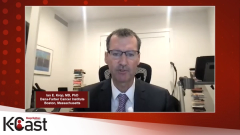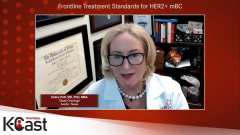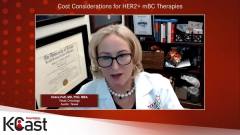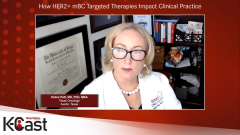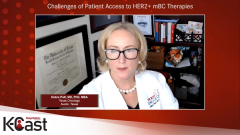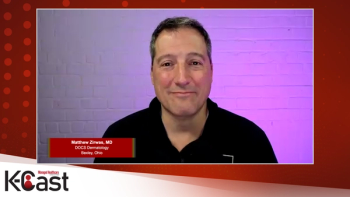
Cost Considerations for HER2+ mBC Therapies
Debra Patt, MD, PhD, MBA, discusses the cost considerations of conventional and novel therapies for HER2-positive metastatic breast cancer.
Episodes in this series

Briana Contreras: For this next segment, we’ll be looking at the regimen-specific costs and cost drivers. How do cost considerations factor into your treatment decision-making?
Debra Patt, MD, PhD, MBA: I think for every therapy that we administer, we want to consider efficacy, toxicity, and cost or value. But specifically, about this population, I think the most important value-based initiative is that patients go on to live disease-free. You can’t discount that, because I think superior efforts and the best possible evidence for disease control is the most appropriate value-based choice. Really, it’s in the patient’s best interest to give the most effective therapy first. That’s the value-based care decision. Because, if you look at outcomes over cost, having a patient that goes years without disease progression, living their life on their standard where they continue to be in the workforce, continuing to interact in meaningful ways with their families; that’s really the most effective way to approach this patient population. We want to keep them on effective treatment. Aside from that, I will say that there are some HER2 [human epidermal growth factor receptor 2]-targeted therapies that are of higher toxicity and higher cost that do require special consideration. We may use them less frequently because of that consideration.
Briana Contreras: Could you share what other kinds of costs need to be considered with these regimens?
Debra Patt, MD, PhD, MBA: I think most of these regimens are relatively low toxicity. Putting patients on effective therapy keeps them in the workforce and their lives in a meaningful way that adds value to them. When you consider the burden of having poor disease control—disease progression, disability, leaving the workforce—those are really expensive choices that aren’t often factored in when we consider our choices about the value-of-care delivery. In addition, there are some therapies that have particular toxicities that can be quality-of-life limiting. For example, if you initiate a patient on treatment with nilotinib, it can cause a lot of diarrhea. That can be a challenge as you think about their costs, because if they are not well-managing that diarrhea, it can diminish the ability to work or participate in their life. In my opinion, there is a real opportunity here for oncologists to shine, because we have the ability to start them on a lower dose and gradually escalate them to accompany their therapy that could potentially be toxic with medications to try to mitigate those toxicities. I think there is an opportunity there for oncologists to act; to reduce some of those toxicities on the patient. That provides a high value care.
Briana Contreras: Thank you. Are you able to share what the primary drivers are of the cost associated with these regimens?
Debra Patt, MD, PhD, MBA: I think a lot of innovator products do have a higher price point. We have a lot of new products in HER2+ [human epidermal growth factor receptor 2-positive] metastatic breast cancer over the last year. Many of them come with a higher price point. I think that’s true even when there is a higher price point when there is a biosimilar on the market. As you know, trastuzumab now has biosimilars. They are also at a high price point because these are therapies that are not chemically made but grown. They are monoclonal antibodies. Some of the innovator and biosimilar products in this space I think do have a higher price point. Again, they are effective therapy, so you need to give them. That’s the high value choice, but they drive costs in this space.
Briana Contreras: Thank you. What is the impact of using HER2-targeted therapies, including dual HER2-targeted regimens, on costs to providers and patients?
Debra Patt, MD, PhD, MBA: So, using dual HER2-targeted therapies does increase the total cost of care. But again, in frontline metastatic HER2 amplified breast cancer it is the most effective therapy that you can provide. Using chemotherapy in combination with dual-targeted HER2 blockade is the frontline regimen that most people use. It does increase the cost of care for patients. But again, I think that in the bigger picture, and certainly in conversations between doctors and patients, patients desire the therapy that is going to give them the best possible outcome. It’s going to keep them living their lives on their terms—whether that’s being teachers, or attorneys, or doctors in the workforce picking up their kids from soccer, at the dinner table with their families—I think that we can’t discount the benefit of having long-term disease control. So, while it does drive cost in this space, it’s really important because it provides tremendous value to patients.
Briana Contreras: What else drives these cost differences?
Debra Patt, MD, PhD, MBA: Chemotherapy that is no longer on patent, like docetaxel for example, is relatively inexpensive in comparison to HER2 blockade, whether it’s an innovator product or its biosimilar equivalent. Those are expensive therapies. But I don’t see that changing in the near term, and it adds so tremendously to the efficacy of the therapeutic intervention. I think it’s necessary to provide high value care.
Briana Contreras: What would the cost implications be of using newer approaches in earlier lines?
Debra Patt, MD, PhD, MBA: If you use newer approaches in earlier lines, you’re unlikely to have biosimilar equivalent to the innovator product. They’re likely to still have patent protection. So, it’s likely that their costs are going to be higher. We are seeing some of our newly approved agents being tested in earlier lines of therapy. We think that if they are approved in that setting, it likely will drive up costs to some degree. Again, I would say that while it is never a trivial issue, the cost of therapeutic intervention is always important to discuss; that the most effective way you can provide good-value, high-value care to patients is to control their cancer.
Transcript edited for clarity.
Newsletter
Get the latest industry news, event updates, and more from Managed healthcare Executive.

